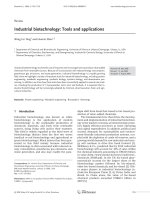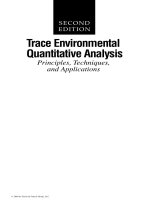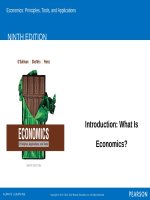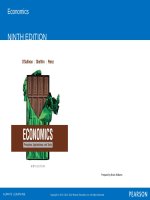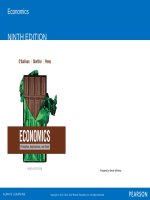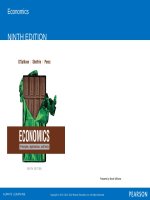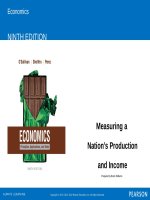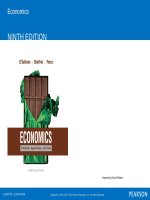Economics principles tools and applications 9th by sullivan sheffrin perez chapter 14
Bạn đang xem bản rút gọn của tài liệu. Xem và tải ngay bản đầy đủ của tài liệu tại đây (2.47 MB, 23 trang )
Economics
NINTH EDITION
Chapter 14
The Federal Reserve
and
Monetary Policy
Copyright © 2017 2015, 2012 Pearson Education, Inc. All Rights Reserved
Learning Objectives
14.1 Explain the role of demand and supply in the money market.
14.2 List the tools that the Fed can use to change short-term interest rates.
14.3 Demonstrate using supply and demand curves how the Fed can determine short-term interest
rates.
14.4 Describe both the domestic and international channels through which monetary policy can affect
real GDP.
14.5 Assess the challenges the Fed faces in implementing monetary policy.
Copyright © 2017, 2015, 2012 Pearson Education, Inc. All Rights Reserved
14.1 THE MONEY MARKET (1 of 4)
•
Money market
The market for money in which the amount supplied and the amount demanded meet to determine the nominal interest rate.
The Demand for Money
INTEREST RATES AFFECT MONEY DEMAND
•
Transaction demand for money
The demand for money based on the desire to facilitate transactions.
Copyright © 2017, 2015, 2012 Pearson Education, Inc. All Rights Reserved
14.1 THE MONEY MARKET (2 of 4)
The Demand for Money
PRINCIPLE OF OPPORTUNITY COST
The opportunity cost of something is what you sacrifice to get it.
As interest rates increase from r0 to r1, the quantity of money demanded
falls from M0 to M1.
Copyright © 2017, 2015, 2012 Pearson Education, Inc. All Rights Reserved
14.1 THE MONEY MARKET (3 of 4)
The Demand for Money
THE PRICE LEVEL AND GDP AFFECT MONEY DEMAND
REAL-NOMINAL PRINCIPLE
What matters to people is the real value of money or income
— its purchasing power—not the face value of money or
income.
Changes in prices and real GDP shift the demand for money.
Copyright © 2017, 2015, 2012 Pearson Education, Inc. All Rights Reserved
14.1 THE MONEY MARKET (4 of 4)
The Demand for Money
OTHER COMPONENTS OF MONEY DEMAND
•
Illiquid
Not easily transferable to money.
•
Liquidity demand for money
The demand for money that represents the needs and desires individuals and firms have to make transactions on short notice without incurring excessive costs.
•
Speculative demand for money
The demand for money that arises because holding money over short periods is less risky than holding stocks or bonds.
Copyright © 2017, 2015, 2012 Pearson Education, Inc. All Rights Reserved
14.2 HOW THE FEDERAL RESERVE CAN CHANGE THE MONEY SUPPLY (1
of 3)
Open Market Operations
•
Open market operations
The purchase or sale of U.S. government securities by the Fed.
•
Open market purchases
The Fed’s purchase of government bonds from the private sector.
•
Open market sales
The Fed’s sale of government bonds to the private sector.
Copyright © 2017, 2015, 2012 Pearson Education, Inc. All Rights Reserved
14.2 HOW THE FEDERAL RESERVE CAN CHANGE THE MONEY SUPPLY (2
of 3)
Other Tools of the Fed
CHANGING RESERVE REQUIREMENTS
If the Fed wishes to increase the supply of money, it can reduce banks’ reserve requirements so they have more money to loan out.
CHANGING THE DISCOUNT RATE
•
Discount rate
The interest rate at which banks can borrow from the Fed.
•
Federal funds market
The market in which banks borrow and lend reserves to and from one another.
•
Federal funds rate
The interest rate on reserves that banks lend each other.
Copyright © 2017, 2015, 2012 Pearson Education, Inc. All Rights Reserved
14.2 HOW THE FEDERAL RESERVE CAN CHANGE THE MONEY SUPPLY (3
of 3)
Other Tools of the Fed
Quantitative Easing
A third way the Fed can change the money supply is by buying or selling long term Treasury bonds, for example, bonds with maturities of ten years. Purchasing
long term securities is commonly called quantitative easing.
Traditionally, the Fed conducted its open market operations by buying or selling short term Treasury bills, with maturities less than three months. By buying or
selling short term Treasury bills, the Fed could effectively control short term interest rates and avoid disruptions to the bond market.
However, sometimes the Fed will want to affect long term interest rates directly. By engaging in a policy of quantitative easing, the Fed can potentially lower
long term interest rates directly at the same time it injects more money in the economy. The Fed began engaging in these policies 2010 to stimulate the
economy and promote a faster recovery.
Copyright © 2017, 2015, 2012 Pearson Education, Inc. All Rights Reserved
APPLICATION 1
QUANTITAIVE EASING AND THE FED’S BALANCE SHEET
APPLYING THE CONCEPTS #1: How did the policy of quantitative easing affect the Fed’s holding of assets?
•
Beginning with the financial crisis in late 2008, the Fed began to engage in an unprecedented series of purchases of securities in the markets.
•
Using its power to write checks on itself, the fed began to purchase long-term government bonds and securities backed by mortgages to drive up the prices
and drive down the interest rates.
•
The Fed’s operations were massive Before these operations, known as quantitative easing the Fed’s balance sheet was less than $1 Trillion and virtually all
of its assets were government securities.
•
By October 2014, the end of quantitative easing, the Fed held $4.5 Trillion in assets and nearly 40 percent are held in mortgage securities.
•
Fed chair Janet Yellen believes selling off large amounts of the assets would unsettle the market, so for the time being, the Fed will not do much of anything
with the securities.
Copyright © 2017, 2015, 2012 Pearson Education, Inc. All Rights Reserved
14.3 HOW INTEREST RATES ARE DETERMINED: COMBINING THE DEMAND AND
SUPPLY OF MONEY (1 of 3)
Equilibrium in the money market occurs at an interest rate of r*, at
which the quantity of money demanded equals the quantity of money
supplied.
Copyright © 2017, 2015, 2012 Pearson Education, Inc. All Rights Reserved
14.3 HOW INTEREST RATES ARE DETERMINED: COMBINING THE DEMAND AND
SUPPLY OF MONEY (2 of 3)
Changes in the supply of money will change interest rates.
Copyright © 2017, 2015, 2012 Pearson Education, Inc. All Rights Reserved
14.3 HOW INTEREST RATES ARE DETERMINED: COMBINING THE DEMAND AND
SUPPLY OF MONEY (3 of 3)
Interest Rates and Bond Prices
HOW OPEN MARKET OPERATIONS DIRECTLY AFFECT BOND PRICES
Bond prices rise as interest rates fall.
GOOD NEWS FOR THE ECONOMY IS BAD NEWS FOR BOND PRICES
•
Increased money demand will increase interest rates.
Copyright © 2017, 2015, 2012 Pearson Education, Inc. All Rights Reserved
APPLICATION 2
DID FED POLICY CAUSE THE COMMODITY BOOM?
APPLYING THE CONCEPTS #2: What is the link between a dollar depreciation and increases in commodity prices?
•
Starting in the summer of 2010, there was a rise in prices of commodities such as oil and food worldwide. Some economists suggested that monetary policy in the
United States was the cause of the worldwide commodity boom. They noticed that commodity prices rose when the U.S dollar depreciated. And they noticed that
the U.S dollar fell largely because monetary policy in the U.S. had driven interest rates down very low because the Fed was using quantitative easing to further
stimulate the economy.
•
Vice-Chair of the Board of Governors, Janet L. Yellen, gave her own perspective in a speech in April 2011 to the Economic Club of New York. She noted that the
sharp rise in commodity prices was many times larger than the dollar depreciation. Moreover, she pointed to increases in worldwide demand and shortages of
supply that were the primary cause of these price increases.
•
Yellin did note that when the U.S. lowered interest rates, other countries also followed for fear that too much capital would flow into their countries if their interest
rates were higher than those in the U.S. Although the Fed might not be directly responsible, the combination of low interest rates worldwide could potentially have
led to the commodity price increases.
Copyright © 2017, 2015, 2012 Pearson Education, Inc. All Rights Reserved
14.4 INTEREST RATES AND HOW THEY CHANGE INVESTMENT AND OUTPUT (GDP)
of 6)
The equilibrium interest rate r* is determined in the money market.
At that interest rate, investment spending is given by I*.
Copyright © 2017, 2015, 2012 Pearson Education, Inc. All Rights Reserved
(1
14.4 INTEREST RATES AND HOW THEY CHANGE INVESTMENT AND OUTPUT (GDP)
of 6)
As the money supply increases, interest rates fall from r0 to r1. Investment spending increases from I0 to I1.
Copyright © 2017, 2015, 2012 Pearson Education, Inc. All Rights Reserved
(2
14.4 INTEREST RATES AND HOW THEY CHANGE INVESTMENT AND OUTPUT (GDP)
of 6)
When the money supply is increased, investment
spending increases, shifting the AD curve to the
right. Output increases and prices increase in the
short run.
Copyright © 2017, 2015, 2012 Pearson Education, Inc. All Rights Reserved
(3
14.4 INTEREST RATES AND HOW THEY CHANGE INVESTMENT AND OUTPUT (GDP)
of 6)
Copyright © 2017, 2015, 2012 Pearson Education, Inc. All Rights Reserved
(4
14.4 INTEREST RATES AND HOW THEY CHANGE INVESTMENT AND OUTPUT (GDP)
of 6)
Monetary Policy and International Trade
•
Exchange rate
The rate at which currencies trade for one another in the market.
•
Depreciation of a currency
A decrease in the value of a currency.
Copyright © 2017, 2015, 2012 Pearson Education, Inc. All Rights Reserved
(5
14.4 INTEREST RATES AND HOW THEY CHANGE INVESTMENT AND OUTPUT (GDP)
of 6)
Monetary Policy and International Trade
•
Appreciation of a currency
An increase in the value of a currency.
Copyright © 2017, 2015, 2012 Pearson Education, Inc. All Rights Reserved
(6
14.5 MONETARY POLICY CHALLENGES FOR THE FED
Lags in Monetary Policy
Inside lags are the time it takes for policymakers to recognize and implement policy changes. Outside lags are the time it takes for policy to actually work.
Influencing Market Expectations: From the Federal Funds Rate to Interest Rates on Long-Term Bonds
It is important to recognize that the Fed directly controls only very short-term interest rates in the economy, not long-term interest rates.
For the Fed to control investment spending, it must also somehow influence long-term rates. It can do this indirectly by influencing short-term rates. The Fed
also tries to influence long-term rates by influencing market expectations about future short-term interest rates and inflation.
Copyright © 2017, 2015, 2012 Pearson Education, Inc. All Rights Reserved
APPLICATION 3
THE EFFECTIVENESS OF COMMITTEES
APPLYING THE CONCEPTS #3: Is it better for decisions about monetary policy to be made by a single individual or by a committee?
•
When Professor Alan Blinder returned to teaching after serving as vice-chairman of the Federal Reserve from 1994 to 1996, he was convinced that committees
were not effective for making decisions about monetary policy. With another researcher, Blinder developed an experiment to determine whether in fact individuals or
groups make better decisions.
•
The results of the experiment showed that committees make decisions as quickly as, and more accurately than, individuals making decisions by themselves.
Moreover, it was not the performance of the individual committee members that contributed to the superiority of committee decisions—the actual process of having
meetings and discussions appears to have improved the group’s overall performance.
•
In later research, Blinder also found that it did not really matter whether the committee had a strong leader. His findings suggest it is the wisdom of the group, not
its leader, that really matters. And to the extent the leader has too much power—and the committee functions more like an individual than a group—monetary policy
will actually be worse!
Copyright © 2017, 2015, 2012 Pearson Education, Inc. All Rights Reserved
KEY TERMS
Appreciation of a currency
Liquidity demand for money
Depreciation of a currency
Money market
Discount rate
Open market operations
Exchange rate
Open market purchases
Federal funds market
Open market sales
Federal funds rate
Speculative demand for money
Illiquid
Transaction demand for money
Copyright © 2017, 2015, 2012 Pearson Education, Inc. All Rights Reserved
